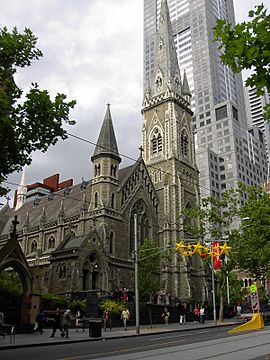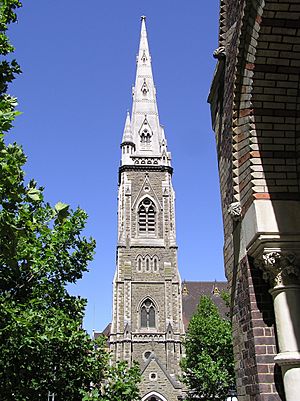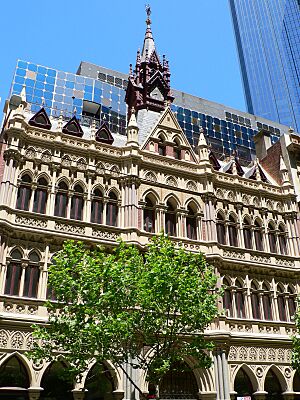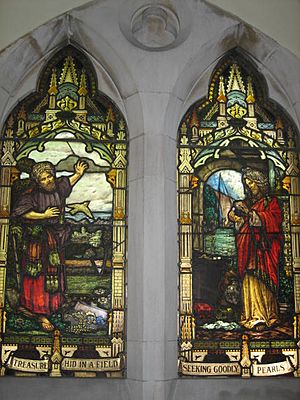Scots' Church, Melbourne facts for kids
Quick facts for kids Scots' Church, Melbourne |
|
|---|---|

The Scots' Church, Melbourne
|
|
| 37°48′53″S 144°58′08″E / 37.81478°S 144.96902°E | |
| Location | 156 Collins St, Melbourne, Victoria |
| Country | Australia |
| Denomination | Presbyterian |
| History | |
| Status | Church |
| Founded | 1838 |
| Founder(s) | James Forbes |
| Dedicated | 29 November 1874 |
| Architecture | |
| Functional status | Active |
| Architect(s) | Joseph Reed |
| Architectural type | Church |
| Style | Gothic Revival |
| Years built | 1871–1874 |
| Specifications | |
| Capacity | 600 |
| Spire height | 61 metres (201 ft) |
| Materials | Freestone |
| Administration | |
| Presbytery | Melbourne West |
| Division | Victoria |
The Scots' Church is a Presbyterian church located on Collins Street in Melbourne, Victoria, Australia. It was the very first Presbyterian church built in the area that is now the state of Victoria. Today, it is still an active church, holding services every Sunday. Many people consider its building to be a famous landmark in Melbourne.
Contents
Early Beginnings
The story of Scots' Church began when Reverend James Forbes arrived in Melbourne in January 1838. He was a Presbyterian minister. Before him, another minister, Reverend James Clow, had already started holding Presbyterian services in a simple building. This was in December 1837. Reverend Clow had retired from his work in India and decided to settle in the Port Phillip District, which is what Melbourne was called back then.
First Church Buildings
Reverend Forbes continued the services that Reverend Clow had started. At first, they used a shared building. But soon, the Church of England claimed that building for themselves. So, Forbes moved the services to a local store. In July 1838, a temporary wooden building was opened. It was called "The Scots' Church." This building was a large room with a fireplace.
On February 3, 1838, a meeting was held to plan a proper church building. They decided to raise money for it. This date is seen as the official start of Presbyterianism in Victoria. The Scots' Church was given a large piece of land at the corner of Collins and Russell streets. Interestingly, the church leaders thought it was "too far out of town" at the time!
The temporary church building also served as a school. Later, in September 1839, the school moved to a new brick building on the same large site.
Building the First Permanent Church
The foundation stone for the first permanent church building was laid on January 22, 1841. The church officially opened on October 3, 1841. It was designed to hold 500 people. Over the years, more features were added, like proper seating, a gallery, and a spire.
Reverend James Forbes also built a simple house for the minister, called a manse, on the church grounds. This manse was later replaced by a two-story house in 1852. The first church building was eventually taken down. This was partly because its tower and spire had developed large cracks and were leaning. Also, the congregation had grown too big for the building.
The Current Church Building
The construction of the beautiful church building you see today began in 1871 and finished in 1874. It was designed by Joseph Reed, a famous architect. He also designed other important Melbourne buildings. These include the Melbourne Town Hall and the State Library of Victoria. The church was built by David Mitchell, who was the father of the famous singer Dame Nellie Melba.
The Scots' Church is built in the Neo-Gothic style. This means it looks like old European cathedrals. It is made from a type of stone called Barrabool freestone. For many years, its spire was the tallest structure in Melbourne, reaching about 61 meters (201 feet) high.
Inside, the church has amazing stained glass windows. These windows show different Christian stories. It also has columns made of basalt stone and a timber roof. The floor is raised so everyone can see the pulpit clearly.
You can also see special flags inside the church. These are the Regimental Colours of the Australian 5th Battalion, The Victorian Scottish Regiment. They include an honor for "LANDING at ANZAC." The crest and flag of former Australian Prime Minister Sir Robert Menzies are also displayed near the lectern. Queen Elizabeth II visited the church in 1961 and again in 1983.
Music at Scots' Church
Music is a very important part of Scots' Church. The main organist and Director of Music since 1984 is Douglas Lawrence.
The Organ
The church has a magnificent pipe organ. The first organ was built in 1883. The current organ was built in 1998 by a company from Austria called Rieger Orgelbau.
The Choir
The choir at Scots' Church is well-known. It has been led by Douglas Lawrence since 1984. The choir has even released recordings of their music. It is said that the famous Australian singer Dame Nellie Melba started and ended her singing career in the choir at Scots' Church. Her funeral was also held there in 1931.
Church Leaders

The first minister of Scots' Church was Reverend James Forbes. He was not only important for starting Scots' Church but also helped establish other significant places in Melbourne. These include Scotch College (a school), the Royal Melbourne Hospital, and the Melbourne Mechanics' Institute.
Today, the senior minister is Reverend Phil Campbell. He is supported by Assistant Minister Reverend Justin Ang. Like all Presbyterian churches, Scots' Church is guided by its ministers and a group of church leaders called elders. This group is known as the session.
Church Services
Scots' Church holds services every Sunday. There is a traditional service at 11:00 am and a more modern service called "ScotsCity" at 5:00 pm. A special service called Communion is held on the first Sunday of each season (autumn, winter, spring, and summer) and on Easter Sunday. The church also hosts a special service before the AFL Grand Final each year.
During the COVID-19 pandemic in 2021, Scots' Church moved its services online. They used platforms like Zoom and YouTube so people could still attend from home.
Since 2007, a group called the Indonesian Christian Church has also joined Scots'. They hold their services every Sunday morning in a building next door to the main church.
Beliefs and Community
Scots' Church is part of the Presbyterian Church of Australia. Its ministers and elders follow a set of beliefs called the Westminster Confession of Faith. This is a major statement of Christian beliefs.
The church also takes part in activities with other Christian churches. For example, Catholic archbishops have preached from the pulpit at Scots' Church. In 2021, Scots' Church worked with another charity, the Salvation Army Project 614. They ran a campaign called "Loving the City to Life." This campaign offered encouragement and free coffee to people in the city after the long COVID-19 lockdown.
A Message of Hope
In 2008, another church in Melbourne displayed posters that called the The Ten Commandments "one of the most negative documents ever written." In response, Scots' Church put up its own poster. It stated that the Ten Commandments are "the most positive and influential document ever written." This showed Scots' Church's strong belief in the importance of these ancient rules.
Images for kids





